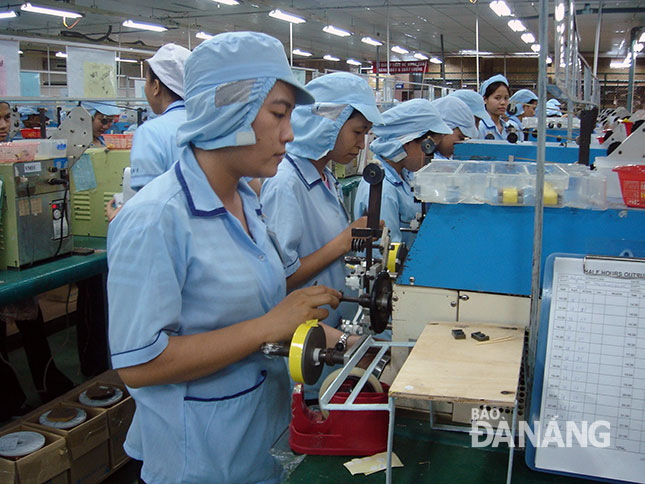Red carpet being rolled out for investors
Da Nang is now home to 6 dedicated industrial parks (IPs) covering a total area of over 1,066ha. They are the Hoa Khanh, expanded Hoa Khanh, Da Nang, Lien Chieu, Hoa Cam and Da Nang Seafood Services IPs.
 |
| Workers at Japan-invested TTTI company |
In particular, 84.01% of rentable space at these IPs have been leased by investors, and a total of over 74,300 employees are working in these IPs.
In addition, there are 1,500ha Hi-tech and 341ha dedicated Information Technology parks in the city.
Recently, Prime Minster Nguyen Xuan Phuc has approved the city’s plans to convert the Da Nang IP into an urban area, and develop 3 new IPs namely the 2nd phase of the Hoa Cam IP covering a total area of 125.14ha, the 405.5ha Hoa Nhon IP, and the 400ha Hoa Ninh IP.
Speaking at the 2017 Da Nang Investment Forum in the city, Prime Minster Phuc asked the local authorities to make even more efforts to enhance the city’s competitiveness, and create an open and transparent investment environment for investors.
Early this year, the national government approved a special mechanism for Da Nang’s Hi-tech Park.
Under the mechanism, domestic and foreign organisations and individuals doing business and working at the Park will enjoy many preferential policies, and investment support mechanisms regarding corporate income and import taxes, investment credit, land lease fees and many other incentives.
Especially, investors will enjoy land lease fee exemptions over the whole life of their projects which use land to develop civil engineering and technical infrastructure works, tree planting areas, public parks, facilities for State-owned agencies, hi-tech human resource training centres, accommodations for experts and employees working in the park, and other projects involved in a list of priority aspects.
Developers of housing projects for sale or lease in the Park will enjoy an incentive corporate income tax rate of 10% in 15 years. In addition, these projects will be entitled to corporate income tax exemption for 4 first years of their operation, and a 50% reduction for the 9 following years.
Especially, any new project with a total investment capital of 3 trillion VND (over 132 million USD) or above will enjoy a rate of 10% for a period of 30 years.
With regard to import tax incentives, import duty exemption for 5 first years will be applied to raw materials, supplies and accessories that cannot be domestically produced, and are imported for production activities at investment projects.
Moreover, there will be many incentives for investment credit, entry and exit procedures, and capital mobilisation mechanism.
Mr Phung Tan Viet, Head of the Da Nang Hi-tech Park Authority, noted that in active response to Da Nang’s landmark campaign ‘2018: The Year of Investment Promotion’, the city authorities have paid special attention to perfecting infrastructure at the 2nd and 3rd phases of the Hi-tech Park project by 2020 in accordance with the city-approved urban planning projects with a focus on essential works and business incubator, training and development centres.
Mr Viet added that the focus was being on appealing for investment into such aspects as information technology, communications, software and electronics, biotechnology, precision mechanical technology and automation, and new energy, new material and nano technologies.
Apart from large-scale IPs, the city will build the Cam Le, Hoa Nhon and Hoa Khanh Nam industrial clusters under the private-public partnership model. Furthermore, the city authorities will facilitate site clearance and compensation work for investors at these industrial clusters.
Top priority will be given to completing procedures relating to the building of the Software Park No 2, the dedicated Information Technology Park and the Information Technology at the FPT technological urban park by the end of this year.
The city is targeting to increase the total number of human resources in software and digital content aspects to around 20,000 by 2020.